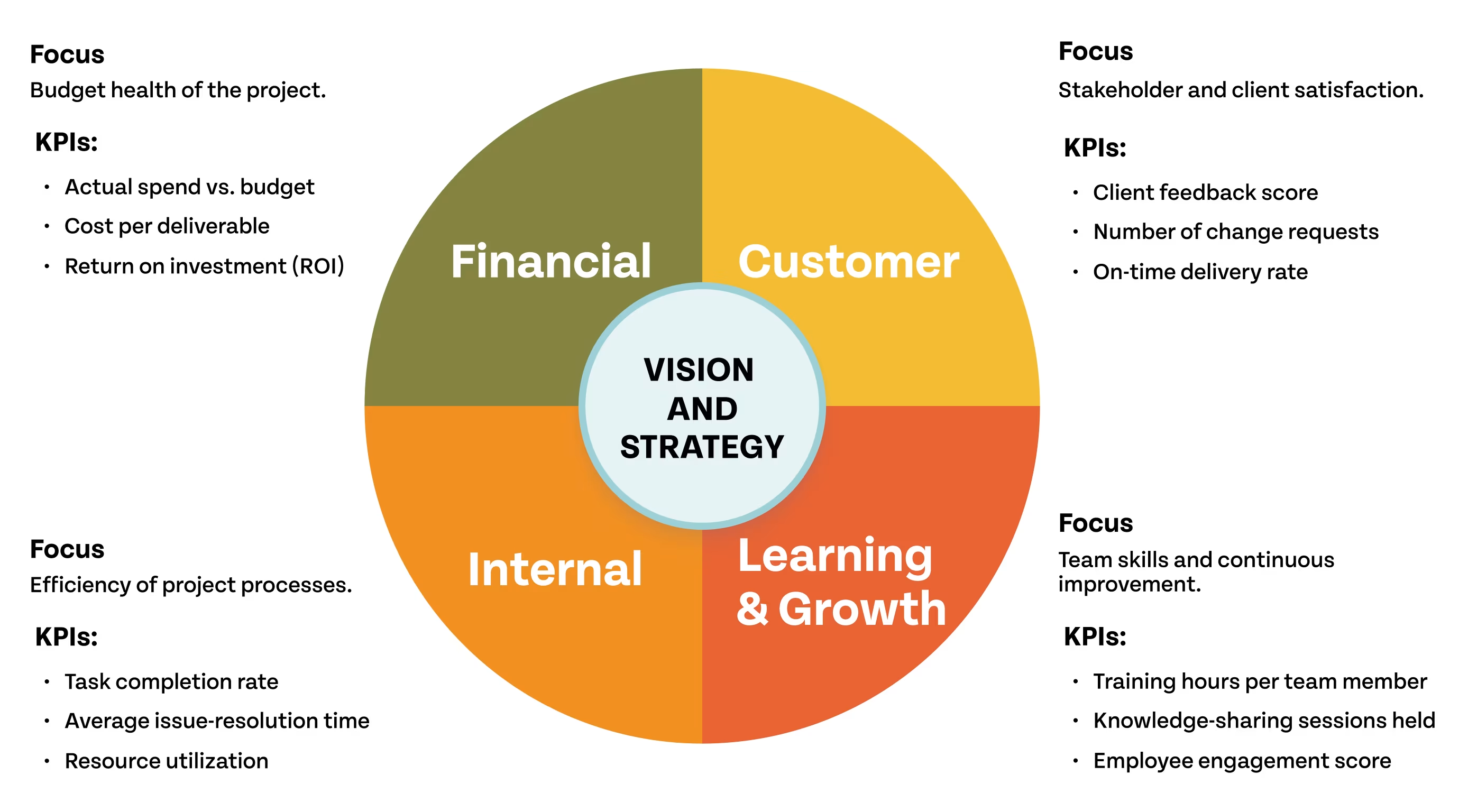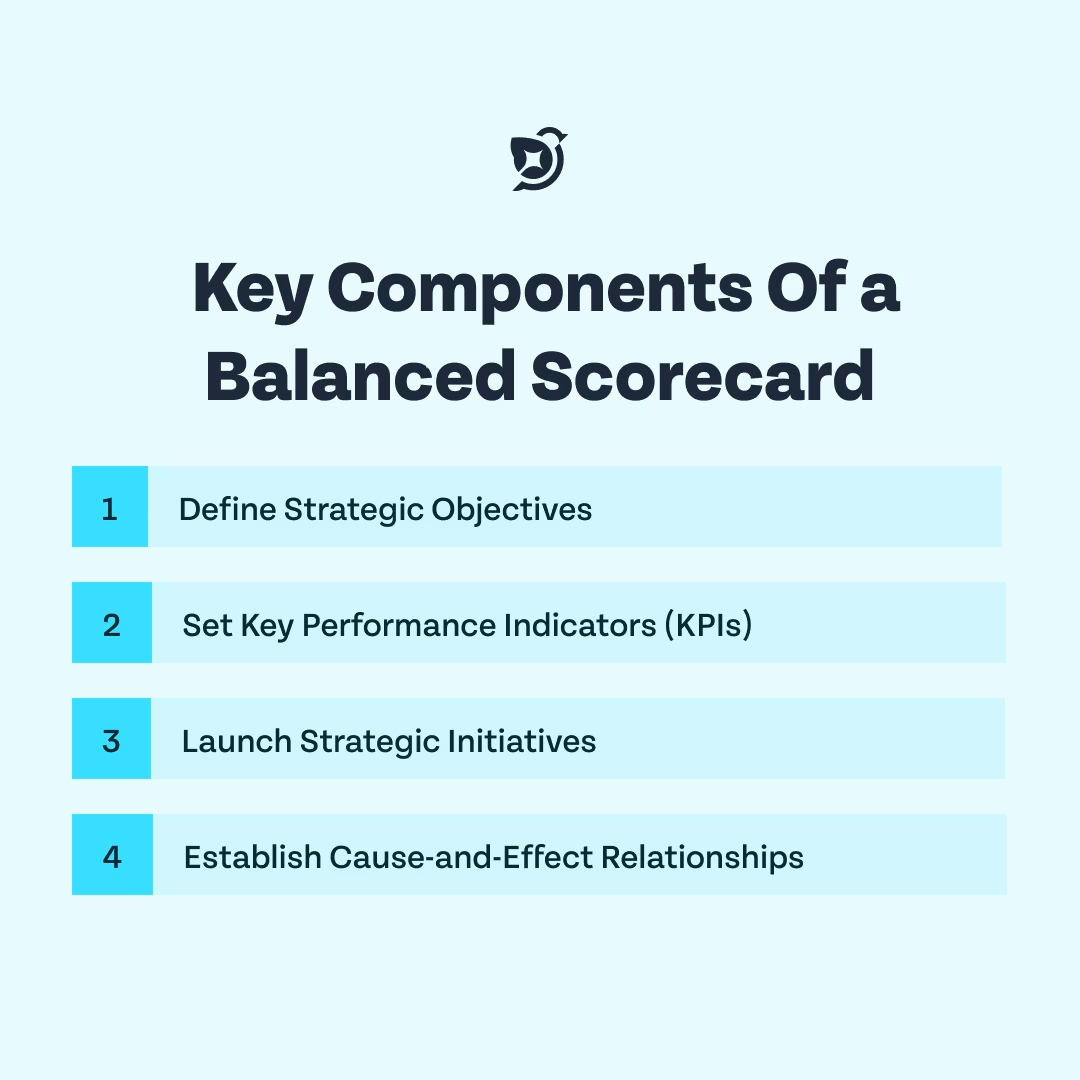If you want to know how top companies consistently align strategy with execution, here’s the secret: they use the Balanced Scorecard. More than half of major corporations across the U.S., Europe, and Asia rely on it as their primary performance framework. Harvard Business Review even ranked it as one of the most influential business ideas of the last 75 years.
The reason is simple: traditional financial metrics tell us where we’ve been, but they don’t tell us where we’re going. The Balanced Scorecard fills that gap by combining financial performance with customer satisfaction, internal processes, and learning & growth.
In this guide, we’ll explore what a Balanced Scorecard is, why it matters, the four perspectives that make it work, and how you can implement it. By the end, you’ll see why this isn’t just a measurement system—it’s a proven way to drive real results.
What Is a Balanced Scorecard and Why It Matters
The Balanced Scorecard is a framework that balances financial and non-financial measures to give leaders a complete view of organizational performance. Instead of relying only on profits or ROI, it combines money metrics with indicators like customer loyalty, employee skills, and operational efficiency.
The term balanced refers to this mix. Traditional ROI measures were fine in the industrial age, but modern businesses compete on knowledge, culture, and technology. The BSC ensures organizations track both lagging results and leading drivers of success.
Why does this matter?
Because financial results are lagging indicators. They tell you what has already happened, not whether your organization is ready for the future. Kaplan and Norton created the BSC in 1992 to balance financial outcomes with forward-looking drivers like innovation, customer loyalty, and employee growth.
Organizations using the Balanced Scorecard consistently outperform those without formal systems because it doesn’t just track results—it helps leaders build the future.
Why Do Businesses Use a Balanced Scorecard?
The simple answer: because it works.
Most organizations struggle with the “strategy gap” — leaders design ambitious strategies, but they never make it into day-to-day execution. The Balanced Scorecard solves this by cascading strategy into measurable objectives and clear accountability.
Here’s what the BSC delivers in practice:
- Clarity: Strategy maps make objectives visual and easy to understand — a “plan on a page.”
- Focus: It avoids random KPIs by showing which metrics drive real outcomes.
- Alignment: By cascading scorecards down through departments, every team knows how their work connects to strategy.
- Efficiency: Resources get tied directly to strategic objectives, reducing wasted budgets on low-impact projects.
For example, Apple has famously used strategy mapping to align product innovation with customer loyalty and financial results and have massive success.
What Are the Four Perspectives of a Balanced Scorecard?
The Balanced Scorecard is built on four perspectives. Each one answers a critical question about your organization. Together, they form a holistic story of performance.
1. Financial Perspective
Question: How do we look to shareholders?
This perspective measures traditional outcomes like revenue growth, ROI, profitability, and cost control. For nonprofits, it’s reframed as resource stewardship. Financials are essential, but they’re lagging indicators. They tell you where you’ve been, not where you’re going.
2. Customer Perspective
Question: How do customers see us?
Metrics here include customer satisfaction (CSAT), NPS, brand perception, and customer lifetime value. The principle is simple: when customers are happy and loyal, financial results follow.
3. Internal Process Perspective
Question: What must we excel at internally?
This includes both mission-critical processes unique to your organization and support processes like HR or IT. Typical measures include cycle times, defect rates, and cost efficiency. Think of this as the “engine room” of your strategy.
4. Learning & Growth Perspective
Question: How will we sustain our ability to change and improve?
It focuses on people, systems, and culture. KPIs often cover employee training, innovation initiatives, and IT capacity. Without this foundation, the other perspectives collapse.

What Are the Key Components of a Balanced Scorecard?
The Balanced Scorecard is more than a reporting framework — it’s a management system made up of interconnected components that turn strategy into action. At its heart, the BSC ensures that every initiative, every KPI, and every department contributes to the bigger picture. It does this by combining four building blocks: strategic objectives, key performance indicators (KPIs), strategic initiatives, and cause-and-effect relationships.
When these elements work together, they transform strategy from abstract slides into a living system that drives alignment, accountability, and results. Let’s break them down:
1. Define Strategic Objectives
Strategic objectives are the foundation of the Balanced Scorecard. They define what your organization is trying to achieve and set the direction for long-term success. These aren’t one-time projects — they’re continuous improvement goals such as “increase customer retention,” “reduce operational costs,” or “strengthen innovation capability.”
Effective objectives are framed as action verbs to signal momentum and progress. Without clear objectives, a scorecard risks becoming a list of disconnected metrics rather than a true strategy map.
2. Set Key Performance Indicators (KPIs)
KPIs bring objectives to life by providing measurable proof of progress. A KPI answers the question: “How will we know if we’re succeeding?”
For example, if your objective is to increase customer retention, a KPI could be “customer churn rate” or “net promoter score.” Good KPIs are specific, relevant, and actionable — they should guide decision-making, not just generate reports.
One of the most common pitfalls organizations face is tracking what’s easy instead of what truly matters, leading to misleading or overloaded dashboards.
👉 Learn more: How to Set SMART Goals that actually drive results to ensure your BSC objectives and KPIs are properly structured for success.
3. Launch Strategic Initiatives
Initiatives are the projects, programs, or actions that move the needle on your objectives. If objectives are the “what” and KPIs are the “how we measure,” initiatives are the “how we get there.” For example, to improve employee engagement, initiatives might include launching a recognition program, rolling out training, or implementing a new HR system. Strategic initiatives ensure that the Balanced Scorecard isn’t just theoretical but actively shapes where time, budget, and energy are invested.
4. Establish Cause-and-Effect Relationships
Perhaps the most unique part of the Balanced Scorecard is its emphasis on cause-and-effect. Strategy isn’t a set of isolated goals — it’s a chain of dependencies. For instance, “invest in employee training” (learning and growth) improves “process efficiency” (internal processes), which enhances “customer satisfaction” (customer perspective), ultimately driving “revenue growth” (financial perspective).
These links are typically visualized in a strategy map, showing leaders how short-term improvements fuel long-term outcomes. Without these connections, it’s easy to lose sight of how today’s initiatives contribute to tomorrow’s success.

How Do You Implement a Balanced Scorecard?
Implementation is about turning theory into practice. Here’s a five-step roadmap:
- Define vision and strategy – Be clear about where you’re headed.
- Set objectives per perspective – Keep it tight with 12–15 objectives total.
- Choose KPIs – Make sure they measure what matters most.
- Develop a strategy map – Show how each perspective feeds into the next.
- Cascade the scorecard – Translate corporate goals into departmental and team-level scorecards.
👉 Cascading strategy doesn’t have to be messy — ThriveSparrow Goals aligns OKRs from top to bottom, so everyone knows how their work drives company success.
Try ThriveSparrow Goals free for 14 days!
What Tools and Tips Improve BSC Results?
The Balanced Scorecard is powerful, but only if supported by the right tools and habits.
Tools: Software like Spider Impact, ClearPoint, and Cascade make it easier to automate data collection, visualize strategy maps, and track initiatives.
Tips:
- Use industry-specific templates to avoid reinventing the wheel.
- Involve employees in design to build buy-in.
- Treat it as a learning system, not a control system.
- Regularly review and revise — strategy is never static.
How Do You Connect the BSC to Performance Reviews?
One of the best uses of the BSC is tying it to employee performance.
When people see how their role impacts strategic objectives, accountability improves and reviews become meaningful. Instead of opinion-based evaluations, they’re tied to real, measurable business outcomes. This creates both motivation and clarity across the organization.
With ThriveSparrow Performance , you can seamlessly connect individual reviews to organizational strategy through 360° feedback, performance heatmaps, and data-driven insights that drive growth.
Try ThriveSparrow Performance free for 14 days!
Final Thoughts
The Balanced Scorecard is more than a framework — it’s a bridge between vision and execution. By balancing financial, customer, process, and learning perspectives, it gives leaders a complete view of organizational health.
It’s not about tracking more metrics; it’s about tracking the right ones. Done well, the BSC ensures short-term results don’t come at the cost of long-term success. Whether you’re a Fortune 500 giant, a nonprofit, or a startup, the BSC provides a roadmap for resilience and growth.
FAQs
Q1. What is a Balanced Scorecard and why is it important?
A Balanced Scorecard is a framework that balances financial and non-financial metrics to align strategy with execution. It matters because it helps leaders see both past results and future readiness. Organizations that use it often report stronger alignment and adaptability.
Q2. What are the four perspectives of a Balanced Scorecard?
The perspectives are Financial, Customer, Internal Processes, and Learning & Growth. Together, they provide a full picture of organizational health. By addressing all four, companies avoid tunnel vision and ensure long-term sustainability.
Q3. How do you implement a Balanced Scorecard?
Start with vision and strategy, set objectives across perspectives, define KPIs, build a strategy map, and cascade it to teams. Success depends on involving employees early and reviewing objectives regularly as conditions change. This keeps the scorecard relevant and actionable.
Q4. What mistakes should you avoid when using a Balanced Scorecard?
Don’t start with metrics before strategy. Avoid copy-pasting generic templates. Don’t exclude staff input or let it become a control tool. The biggest mistake? Not revisiting the scorecard when strategy shifts — that makes it obsolete.
Q5. How does a Balanced Scorecard improve performance?
It links daily work with long-term goals, improving clarity, accountability, and alignment. Over time, this strengthens decision-making, boosts employee engagement, and sharpens competitive advantage. Companies using it often see measurable gains in both efficiency and innovation.

















